Photo
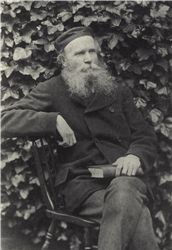
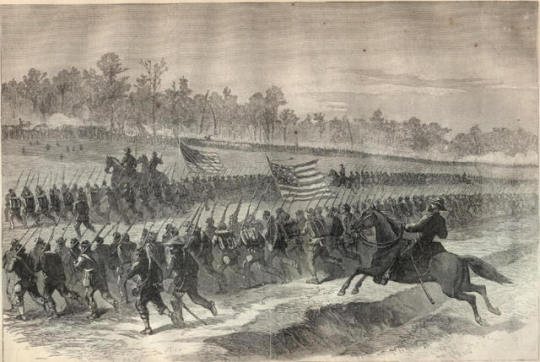



William Chester Minor graduated from Yale Medical School in 1863 with a degree and a specialization in comparative anatomy. By May of 1864 he was a surgeon in the Union army. He served at the Battle of the Wilderness, which is known for being a very brutal and bloody fight with many casualties on both sides. He also was once given the job of branding a soldier with a red hot D, for deserter, on his face. On his off time he would visit the local brothels, something his commanders didn’t really approve of. They sent him to Florida where his paranoia began to really show itself. He became scared of his fellow officers, afraid they would hurt him. The army sent him to an institution and he was diagnosed with having a mental illness. He was released after 18 months.
In 1871 he moved to London and unfortunately he became even more paranoid. He felt that he was always being followed by an unknown group, he even went to Scotland Yard with his fears but they couldn’t help. On February 17th, 1872, he awoke and saw what he thought was someone at the end of his bed. Terrified, he grabbed his pistol and chased this phantom intruder out into the street. Sadly he ran into a man named George Merrett who was on his way to work, and mistook him for his constant pursuers. He shot and killed Merrett on the street. He was arrested and sent to trial.
During the trial it came to light that he had been seeing people following him since his release from the American asylum. Also the prison guards who watched him while he awaited the trial testified he would wake up screaming, claiming to have been sexually abused by people living in the floorboards and in the walls. He was found not guilty by reason of insanity and sent to Broadmoor asylum. He wasn’t considered a serious threat and had a pension from the army which would help pay his bills, so he was given a comfortable cell and access to books and writing materials.
He soon found out that the Oxford English Dictionary, still being written, was looking for volunteers to help get the english language on paper. He became one of the most prolific contributors the dictionary folks had. Through his vast collection of books and access to a good library he was able to gather quotes that explained how particular words were used. The dictionary people would even compile lists of words for him to look up and find the right quotes to make it work. Even the wife of the man he murdered would visit often, bringing him books for his collection. In 1899 Dr. James Murray, the O.E.D’s editor, said of Minor “We could easily illustrate the last four centuries from his quotations alone.”
Sadly Minor’s condition worsened over the years. In 1902, because he thought he was being taken from the hospital and flown all over the world to sexually assault children, he cut off his penis. In 1910 he was released and deported back to America to St. Elizabeth’s Hospital. He was diagnosed with dementia praecox, a chronic and deteriorating psychotic disorder. In 1919 he was moved to the Retreat for the Elderly Insane in Hartford, Connecticut and the next year he passed away.
Pictured above: William Chester Minor, a depiction of the Battle of the Wilderness, an O.E.D pamphlet asking for volunteers, Broadmoor Asylum and lastly his grave.
95 notes
·
View notes
Photo



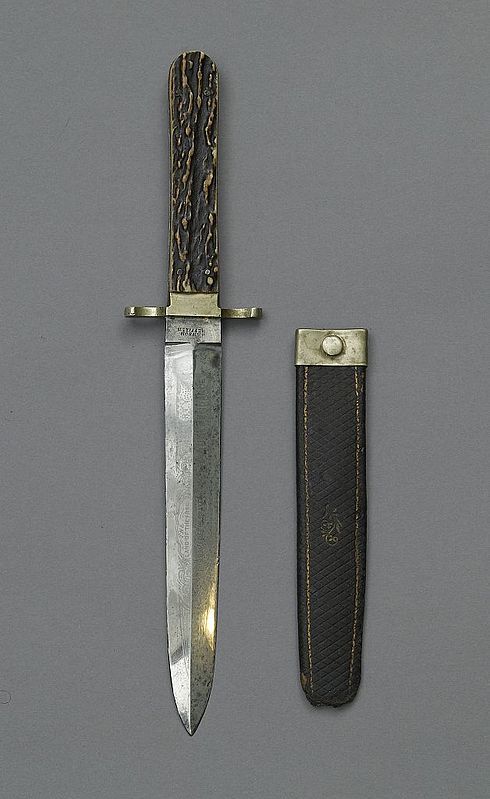


On April 18th 1865 Major Henry Reed Rathbone and his fiancee Clara Harris accepted an invitation to the theater from some very powerful friends. Those friends were the President and First Lady of America, Abraham Lincoln and his wife Mary Todd. Everyone knows the story of that fateful evening. John Wilkes Booth assassinated President Lincoln by shooting him cold-bloodedly from behind as they watched the play. Rathbone and Harris were there. They were in the booth, they were covered in blood. Major Rathbone tried to stop Booth and for his attempt he was cut on his left arm, from his elbow to his shoulder. After Booth made his escape, Lincoln was brought to a nearby house in an attempt to save his life. It was only then that Rathbone discovered the injuries on his arm were worse than he thought. His wife cradled him in her lap as he faded in and out of consciousness, the cut having severed an artery. Clara Harris wore a white dress that night, and the blood on her dress was very prominent. She would go on to say:
“Poor Mrs. Lincoln, all through that dreadful night she would look at me with horror and scream oh, my husband’s blood… my dear husband’s blood… It was Henry’s blood, not the President’s, but the explanations were pointless.”
Lincoln died the next morning.
Rathbone survived the injury and would go on to marry Clara Harris on July 11th 1867. They had three children together. He resigned from the Army in 1870 and his mental health began to decline. He felt immense guilt over what he thought was a failure in protecting President Lincoln’s life. He began to drink, gamble and have affairs. These Hobbies led to him not being able to hold down a job which took its toll on the family. Adding to the strain every year newspapers and journalists would come calling, asking them to relive the most horrific night of their lives. Clara would later write to a friend:
“I understand his distress… In every hotel we are in as soon as people get wind of our presence we feel ourselves become objects of morbid scrutiny… Whenever we were in the dining room we began to feel like zoo animals. Henry… imagines that the whispering is more pointed and malicious than it can possibly be.”
As his mental health declined Rathbone became convinced that his wife was just as unfaithful as he was. He was jealous of the attention she would give to their children and began to publicly threaten her. Even though he was slowly deteriorating, president Chester Alan Arthur appointed him US Console to the province of Hannover in Germany. He and his family moved to a new country and Clara hoped for the best.
It was hopeless, Henry continued to lose his mind. On December 23rd, 1883 he attacked his family. He shot Clara in the head and stabbed her repeatedly as she protected the children. He then attempted suicide by stabbing himself 5 times in his chest. Clara died that night, Rathbone would survive the attempt, as would his children, who were sent back to America to live with their uncle. Rathbone was charged with murder but later he was declared insane by doctors and committed to an asylum for the criminally insane in Hildesheim, Germany. There he languished until August 14th, 1911, where he died in his cell. He was buried next to Clara in a plot in Germany.
Pictured above: Clara Harris Rathbone, Major Henry Rathbone, a depection of Lincoln’s assassination, the knife used by Booth to slash Rathbone, a newspaper article about Rathbone’s life and lastly a map of Germany with Hannover highlighted.
54 notes
·
View notes
Photo
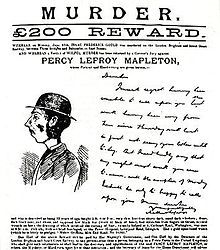


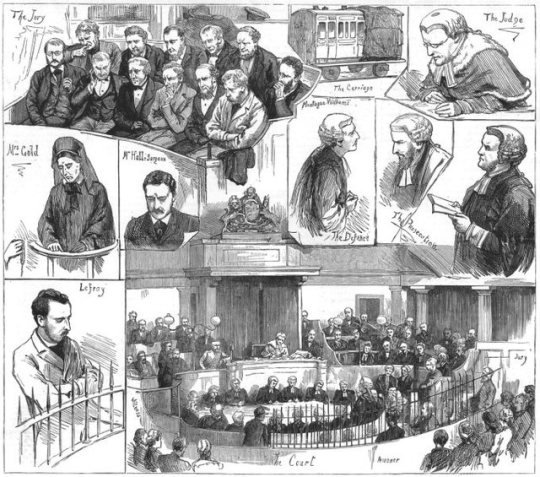


On June 27th 1881 when the train arrived at Preston Park Station in London, Percy Lefroy Mapleton was seen coming out of the smoking compartment in a very disheveled state. He was covered in blood, had lost and his hat collar, and, strangely had a gold watch chain hanging from his shoe. He went to the ticket collector on the train and claimed that he had been attacked by two men who had knocked him out. He accompanied the ticket collector on the rest of his journey to Brighton, and he then informed the stationmaster that he had been shot. He was brought to the local police station and made a complaint against his alleged attackers but after going to the hospital for treatment it was revealed his wounds weren’t as bad as he said they were, which left the cops suspicious.
While he was being interrogated, the smoking carriage had been searched and they found signs of a struggle. Blood on the carriage’s footboard, carpets and the door handle as well as on a handkerchief and a newspaper. The tracks were searched and the body of an elderly man was found. He had been shot and stabbed, near the body they found a knife covered in blood. The body was identified as Isaac Gold, a coin dealer. It was evident he had a large sum of money and his gold watch stolen. The stationmaster told the authorities who then made sure that Mapleton was put under guard at the Boarding House in which he was staying.
He persuaded the officer watching him to wait outside as he changed his clothes and made his escape. The police issued a warrant and a description of Mapleton to the newspapers, which included the very first artist’s impression of a suspect to be published in a British newspaper. His depiction was on the front page and it brought enormous public interest. He was sighted all over the country but nothing panned out until Mapleton made a dumb move. His employer brought forward a telegram which asked that Mapleton’s wages be sent to a house in Stepney, London, under the name of Park. In his room authorities found bloodied clothes from the day of the attack. He was also identified as a man who had pawned a revolver and some counterfeit coins, which were stolen off Gold. He was arrested and sent to trial at Maidstone Assizes.
A number of witnesses came forward to give evidence and this included a woman who saw two men struggling violently in the train as it passed her house. During the trial it was revealed Mapleton was broke and had went out that day specifically to rob someone. He wanted to rob a woman but instead went with the elderly Mr. Gold. After deliberating for only 10 minutes the jury returned a verdict of guilty and he was sentenced to death. While he was waiting for his execution he confessed to another murder, but quickly recanted the confession. On November 29th 1881 he was hanged at Lewes prison. This case is important in the history of crime as it was the first to use a police sketch in a newspaper to help identify the suspect for capture.
Pictured above: the newspaper wanted poster, a closer shot of the police sketch, Mapleton himself, a depiction of the people involved, a newspaper article about the case and an illustration of his execution.
68 notes
·
View notes
Photo
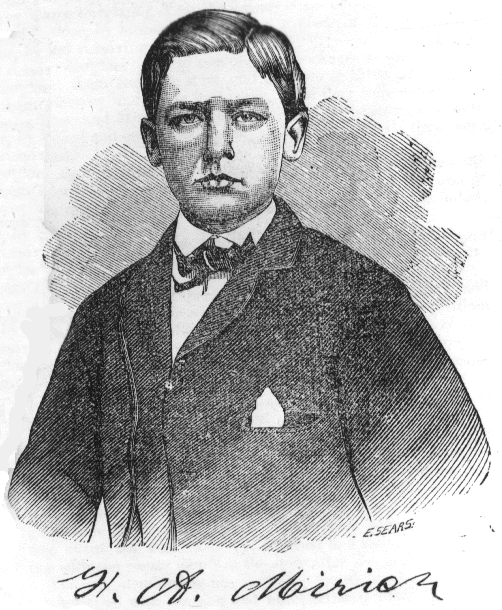
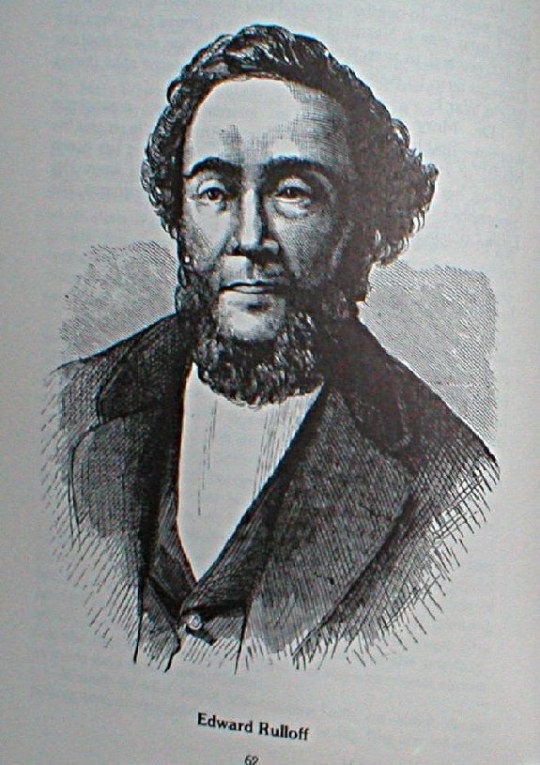


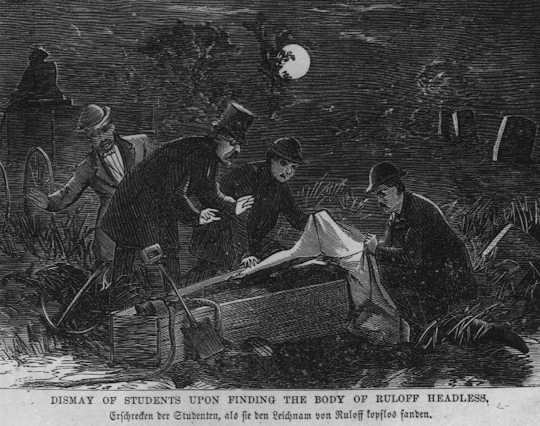
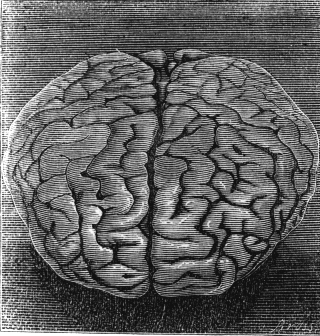


Edward H. Rulloff was born in the early 1800s. He was said to be a genius, though he was self-educated, no formal education. He supposedly spoke several languages and became an expert in the study of language in written historical sources, or philology. He wrote a paper on the theory of language origins called ‘The Method of Languages’ and it was submitted to the American Philosophical Association. Although a genius, he still had his problems.
He was accused of many crimes throughout his life and spent time in Sing Sing prison for embezzlement. He moved to Ithaca, New York, and there he was accused of beating his wife and his daughter to death as well as poisoning his sister-in-law. He is said to have been insanely jealous that his wife Harriet had a fling with her cousin. He had told her that he had poisoned her cousin and his family out of revenge, then quickly recanted it as a joke. One night while arguing his temper took hold and he clubbed her in the head causing her to fall with the baby in her arms. The next day he borrowed a wagon from a neighbor to transport a large wooden chest. It is suspected that in the chest were the bodies of his wife and child, which he then dumped into Cayuga Lake. When he returned, the town suspected him of killing his family and he was arrested, but without a body to prove it he was let go. Finally in 1870 he was brought to Justice after he murdered a store clerk named Frederick Merrick in Binghamton, New York, during a robbery.
His trial was a media sensation due to his noted intellect, but academic celebrity or not he was charged with murder, facing a death sentence. There were many objections from the public to his death sentence considering his brainpower. Even Mark Twain wrote an editorial saying “…half the mystery of his strange powers is yet a secret.” His past notoriety and all of the negative rumors surrounding him did not help his case. The courts were not swayed and he was eventually sentenced to death. Near the end of his life he began to be very angry at his situation, swearing if only he had more time he could finish his great intellectual work. A week before his death he said:
“…you cannot kill an unquiet spirit, and I know that my impending death will not mean the end of Rulloff. In the dead of the night, walking along Cayuga Street, you will sense my presence. When you wake to a sudden chill, I will be in the room. And when you find yourself alone at the lake shore, gazing away at gray Cayuga, know that I was cut short and your ancestors killed me.”
On May 18th, 1871, he was hanged. He is reported to have said as his last words, after a brief speech: “Hurry it up! I wanted to be in the hell for time in time for dinner.” After his death his body was sent for an autopsy and it was discovered that his head was abnormally huge. His skull was crazy thick, the pathologist said “It was a natural helmet that would have defied the force of any pistol bullet.” His brain weighed 1673 grams, or nearly half a gallon, and was one of the largest human brains ever measured. Compared to the average male brain size of 1300 grams it is quite a large difference. His brain was even bigger than Einstein’s. Rulloff’s brain has, for over 140 years, been sitting in a jar in the Wilder Brain Collection in the Department of Psychology at Cornell University.
Pictured above: the victim Frederick Merrick, Edward H. Rulloff, an illustration of the murder, an illustration of the attack on his wife, a picture of some med students digging up his grave only to their dismay find his head all ready gone, an illustration of his brain from the 1800s, his brain today and lastly the shelf in the basement of Cornell where it sits gathering dust.
97 notes
·
View notes
Photo

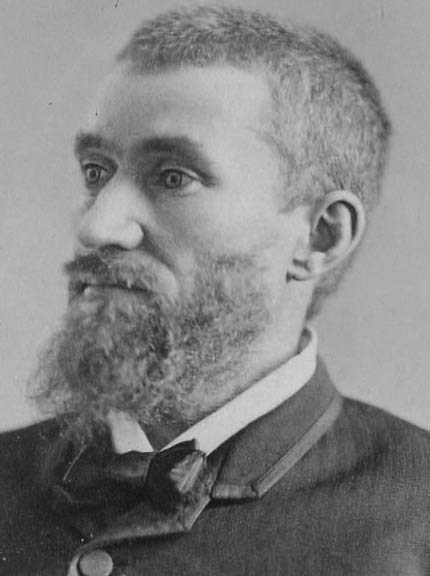

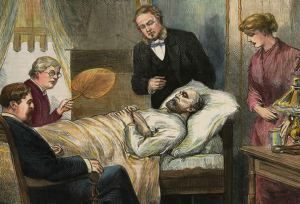



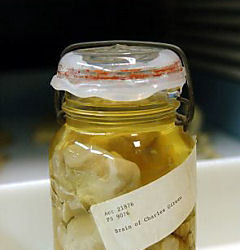
Charles Julius Guiteau was an American who assassinated his own president, James A. Garfield, in 1881. He was born in Illinois and raised in a large family eventually moving to Michigan to attend University. After flunking out he headed off to join a cult or “religious sect” in Oneida, New York in 1860. Even in a group as close as a cult he was an outsider, they even nicknamed him Charles ‘Gitout’, as in ‘get out’. He decided to leave the cult for obvious reasons and embarked on a few different career paths before his ultimate decision to end the life of the American president.
First off he started a newspaper based on the teachings of the cult he had just left, but the paper soon failed. Then he tried to be a lawyer in Chicago. He was not very good and only took part in one actual court case. His ex-wife would later attest that he was not an honest lawyer, mostly bilking his clients out of their cash. After the law career didn’t pan out he turned to theology, attempting to write a book of his religious rants and ravings, which actually was plagiarized from the leader of the cult he used to be affiliated with. In 1880 he showed up in Boston but was soon on his way under a cloud of suspicion of robbery or theft. On June 11th 1880 he took a ride on the passenger ship SS Stonington. That night, in a heavy fog, the Stonington collided with the SS Narragansett. Although the Stonington had no injuries and got away, the Narragansett burned and sank with a large loss of life. Guiteau believed he survived for a higher purpose, so he turned to the world of politics.
Originally he supported Ulysses S Grant and wrote a speech in favor of the man but he soon switched things up to favor the soon to be president Garfield. After Garfield won the nomination in 1880 Guiteau began delivering copies of the speech to members of the Republican National Committee and delivered it out loud to a crowd twice. He believed himself to be the main reason Garfield was elected president. During his trial he even stated that it was his speech that had elected Mr. Garfield as president of the United States. He wanted an ambassadorship as payment, asking for Vienna but eventually he would decide Paris was more to his liking. Of course he was rejected, multiple times, and finally on May 14th 1881 he was told by James G. Blaine, the Secretary of State, to never return to seek any kind of payments for any supposed or alleged deeds done for the president.
After that encounter Guiteau went out and bought a .442 calibre Webley British Bulldog revolver. He decided to go with the ivory handled option as it would look much better in a museum exhibit after the assassination, some serious premeditation. He spent a couple weeks practicing on a target and stalking President Garfield. Once he tracked Garfield to a railway station but decided against killing him as his wife Lucretia was not healthy and Guiteau didn’t want to upset her. So on July 2nd, 1881, he staked out the Baltimore and Potomac Railroad Station, waiting for his victim. Garfield was going on a vacation and Guiteau knew it. As the president passed through the station he stepped forward and shot the president twice in the back. As he surrendered he is said to have claimed “I am a stalwart, of the stalwarts! Arthur is president now!” (Chester A. Arthur)
Garfield died after a long painful battle with infection. It’s thought that it was possible he may have survived the attack had the doctors not been so unsanitary. Proper sanitation in medical procedures wouldn’t be used in america for another 10 years. Guiteau was sent to trial on November 14th 1881 and tried to go with a plea of insanity. Attempting to represent himself he would go on to swear at and berate the judge and the jury for the entire trial.
Dr. Edward Charles Spitz, a leading alienist (which was a form of psychiatry), would testify that Guiteau was “not only now insane, but that he was never anything else.” He testified that he had no doubt that the man was insane. He claimed that Guiteau had the “insane manner” that he had seen in many asylums and said that he was a “morbid egotist” with a “tendency to misinterpret the real affairs of life.” The District of Columbia’s district attorney was George Corkhill, who had this to say about Guiteau’s Insanity defense:
“He’s no more insane than I am. There’s nothing of the mad about Guiteau: he’s a cool, calculating blackguard, a polished ruffian, who has gradually prepared himself to pose in this way before the world. He was a deadbeat, pure and simple. Finally, he got tired of the monotony of deadbeating. He wanted excitement of some other kind and notoriety… and he got it.”
During the trial Guiteau would give his testimony in epic poems that he would recite at length, he would also ask for legal advice from random people in the audience. He dictated an autobiography to the New York Herald, ending it with a personal ad for a “nice Christian lady under 30 years of age.”. He loved all the attention that America was giving him, it was the first time he was the center of attention, although he seemed to not notice (or care) that the attention was purely hatred. He sent a letter to the new president Chester A. Arthur asking to be freed seeing as he had increased Arthur’s salary by killing Garfield. But it was all for naught, he was found guilty on January 25th 1882. He would yell and scream at the jury after the guilty verdict, calling them all “consummate jackasses.” He appealed but the appeal was quickly rejected and on June 30th he was led to the Gallows in the District of Columbia.
He is said to have been in good spirits, smiling and waving to all the reporters and spectators in the crowd, again happy to be the center of attention. He danced his way up to the gallows and even shook hands with the Executioner, he then recited a poem that he wrote called “I am going to the lordy.” After he was hanged he was originally buried in the corner of a jail yard, however seeing that pieces of the rope that hang him we’re being sold as macabre souvenirs, the authorities decided to send his body to the National Museum of Health and Medicine in Maryland. They preserved his brain and his enlarged spleen and they bleached his skeleton. Currently part of his brain remains on display at the Mütter Museum in Philadelphia.
Pictured above: a picture of the victim president Garfield, a picture of the assassin Guiteau, a depiction of the crime, a depiction of the president’s final hours, an illustration of the trial, a shot of the same brand gun Guiteau used, a pass to the trial from 1881 and lastly what remains of Guiteau’s brain in a jar.
69 notes
·
View notes
Photo
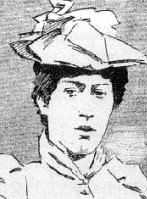
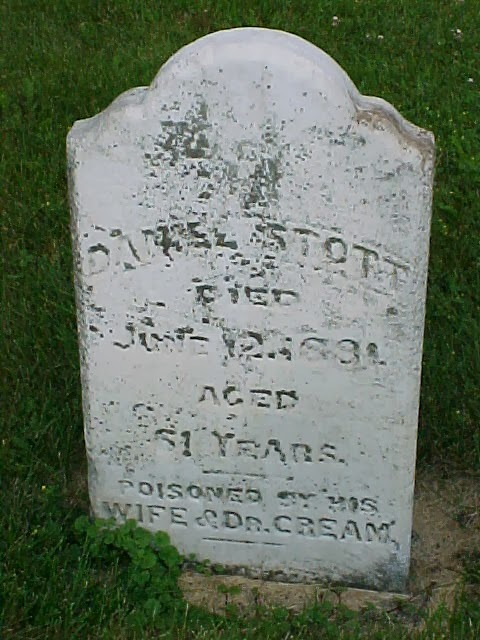


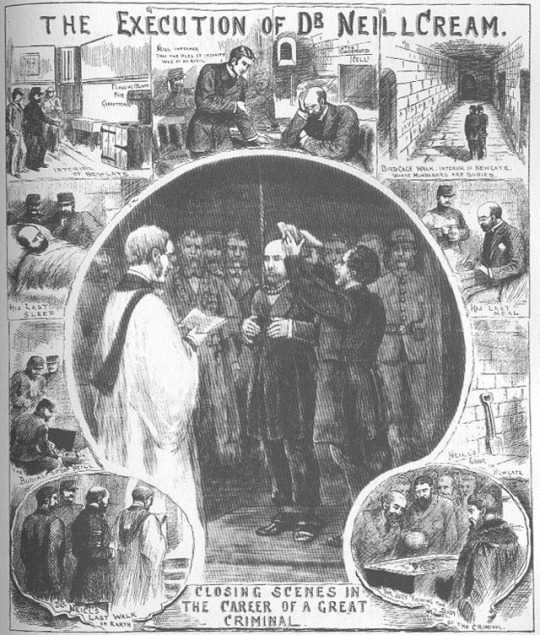

In August of 1879 a woman named Kate Gardener was found dead in an alleyway. After an investigation it was discovered she was poisoned with chloroform and also that she was pregnant. It was known around town that she was having an affair with a local doctor named Thomas Neill Cream. They went to ask Dr. Cream some questions about her death he claimed she was impregnated by a different guy, a prominent businessman, but the cops weren’t buying it. Cream made the decision to flee to the United States to avoid any more questions. Dr. Cream was born in Glasgow and raised in Quebec City, Canada. He went to McGill University in Montreal where he graduated in 1876. After his postgraduate studies he settled and opened a practise in London, Ontario.
After the murder accusations he fled to Chicago where he offered illegal abortions to prostitutes. Between 1880 and 1881 there were three murder investigations opened on Dr. Cream, but none of them had enough evidence for the authorities to take any action. They were all poisons, usually strychnine, but there was nothing directly connecting them to Dr. Cream. Finally the cops got their break. In 1881 a man named Daniel Stott was found dead of strychnine poisoning after Dr. Cream had supplied him with a remedy for epilepsy. Although his death was attributed to natural causes, for some reason Dr. Cream wrote to the coroner blaming the pharmacist for Stott’s death. The authorities investigated and instead of arresting the pharmacist as Cream was hoping, they went after his blackmailer: Dr. Cream himself. He was arrested with his mistress, but she turned evidence against him to avoid some jail time he was sentenced to life imprisonment in Joliet prison. In 1891 his sentence was commuted after his brother pleaded for leniency and also allegedly bribing the right people.
He left America and went to England, establishing a new practice in Liverpool and settling on Lambeth Palace Road, a poverty stricken area at the time. In 1891 a nineteen year old prostitute was given a drink by Dr. Cream, the next day she was sick, she was dead within a week from strychnine poisoning. During the investigation Cream again wrote to the coroner, this time offered the name of the murderer for a three hundred thousand pound reward. On October 20th he spent the night with another prostitute and again, the next morning she was found dead in her apartment. Cream wrote another note to the presiding physician, this time accusing the physician himself of murder and asking for a bribe to keep his mouth shut. On April 11th Cream had a date with two more young ladies of the night. He brought with him two special bottles of Guinness. He left before the poison could start its work but apparently both women died in extreme pain over night.
Cream had written many accusatory letters and all of those accused turned out to be completely innocent after investigated. The authorities figured he knew more than he was telling. Also he had referred to one of the deaths, which had been diagnosed as from a natural cause, as a murder. They soon realized that he might be the serial killer who newspapers were calling ‘the Lambeth Poisoner’. Scotland Yard put him under surveillance and after watching him and his prostitute addiction for a short time they contacted the United States and discovered he had been in jail for murder, specifically he had poisoned a man and been a suspect in other murders.
On June 3rd, 1892 he was arrested and formally charged with five murders, one attempted murder and extortion. He tried to say that he was not the man they were looking for, he claimed he was Dr. Thomas Neill, not Dr. Thomas Neill Cream, but that did not work. After a four-day trial and the jury deliberating for only 12 minutes he was found guilty and sentenced to death. Less than a month after his conviction he was hanged at Newgate Prison and was buried in an unmarked grave. It’s said that while being hanged his last words were “I am Jack the…” he was hanged before he could finish the sentence. It has been speculated that he was confessing to being Jack the Ripper, however these are completely unsubstantiated claims. Although one of the more humorous explanations for his last words were from one of Cream’s biographers. It was suggested he was so scared on the scaffold that he lost control of his bodily functions and mumbled “I am ejaculating…” which could have been mistaken for “I am Jack…”. Including the five deaths he was convicted for, it is also suspected he murdered his first wife Flora Brooks in 1877 and at least four other women who had died on his table while he performed illegal abortions.
Pictured above: an illustration of one of his victims Matilda Clover, the grave od the man he killed in Chicago, some newspaper and penny dreadful illustrations about the crime, his capture and execution and lastly Lambeth, England where he made his name.
156 notes
·
View notes
Photo

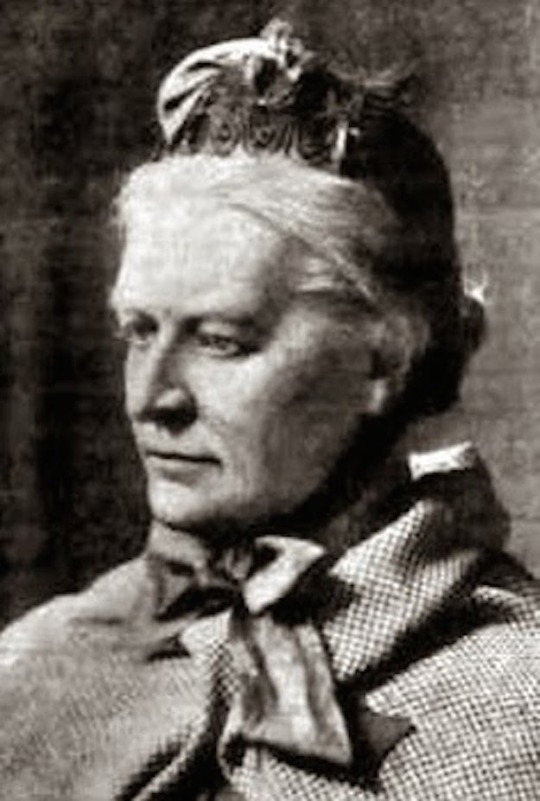





Born in 1837 in Pyle Marsh, Bristol, England, Amelia Dyer grew up with death and sadness. By 1848 she had seen two of her sisters pass away and her mother slowly and painfully die of typhus. She grew up and eventually started training as a nurse. This is when she met a woman named Ellen Dane from whom she learned the art of baby farming. Baby farming was a terrible practise in the eighteen-hundreds Victorian era. The idea was much like an orphanage, only instead of government funded and controlled it was women who placed ads in newspapers saying they would take the baby for a fee. Sometimes the baby would be put up for adoption, sometimes the parents would return for them. Either way it was completely unlicensed, no rules, no regulations. Dyer decided to use baby farming, an already disgusting and abuse filled occupation, in an even more evil and nefarious manner, specifically the extermination of the babies. These children were born to illegitimate families, out of wedlock, or to people unfit to care for the child. These parents would pay Dyer from 10 to 80 pounds to take their kids. Dyer would end up killing the child, selling the clothes and moving on to her next victim.
She met and married a man and the two had a couple of children, a family she now used as a helpful cover for the untrusting expecting mothers. In 1879 she was arrested after a doctor noticed how many children had died under her care. She was arrested and although she should have been tried for the deaths she was only tried for neglect and received six months of hard labour. She said the experience destroyed her mentally and from then on she would experience mental breakdowns, conveniently any time the authorities were on her trail.
In 1890 she cared for an illegitimate baby. When the mother returned to take the child away she was given a baby she didn’t recognize. She stripped the child down and noticed that there was no birthmark where there once was on one of his hips. It didn’t take long for the authorities to suspect Dyer, so she had another breakdown and went into a mental institution. After a number of years and a number of doctors bringing her to the authorities attention she decided to no longer bring the bodies to doctors, she would just dispose of them. When the families returned or someone came sniffing around Dyer and her family would move to another town.
On March 30th 1896 a small package was pulled out of the Thames river at Reading in London. Inside the package was the body of a baby girl. The detectives were able to find a label from Temple Meads station, a railroad station, and on that label, under microscopic analysis, they found a name: Mrs. Thomas, and an address. This led the police to Dyer. Although they had no strong evidence directly connecting her to the body found they spoke with other police forces and witnesses and came to the conclusion that this was their killer. Her house placed under surveillance and a young woman was set up as a decoy to meet with Dyer and discuss adoption for her illegitimate child. On April 3rd Good Friday the police raided her home as she waited for her new client, the police decoy. They found no bodies but they did find other evidence that later on in the case would become very relevant, including white edging tape that she would use as a noose for the babies, telegrams regarding adoption arrangements, the tickets from pawn shops where she would sell the children’s clothing that she had murdered and receipts from the advertisements that she would place in newspapers offering her services as a ‘want to be mother’.
At the time the police calculated that in the past few months at least 20 children had been placed under her care and murdered, at that rate of murder it’s estimated that over the decades she had killed over 400 babies and children making her one of the most prolific murderers ever. On April 4th she was arrested and charged with murder along with her son in law and her daughter, both would eventually be released after no evidence was found suggesting they were in on the crime. That month authorities searched the Thames and six more bodies were discovered, each child had been strangled with the white tape police had found at her house.
Her trial began on May 22nd 1896 where she pleaded guilty to one murder. Her defense was insanity, however the prosecution was able to bring to light the fact that any time she had a mental breakdown coincided with a time that she was about to be exposed. It took the jury only four and a half minutes to find her guilty. In the three weeks before her execution she wrote a last and only true confession.
“Sir will you kindly grant me the favour of presenting this to the magistrates on Saturday the 18th instant I have made this statement out, for I may not have the opportunity then I must relieve my mind I do know and I feel my days are numbered on this earth but I do feel it is an awful thing drawing innocent people into trouble I do know I shal have to answer before my Maker in Heaven for the awful crimes I have committed but as God Almighty is my judge in Heaven a on Hearth neither my daughter Mary Ann Palmer nor her husband Alfred Ernest Palmer I do most solemnly declare neither of them had anything at all to do with it, they never knew I contemplated doing such a wicked thing until it was too late I am speaking the truth and nothing but the truth as I hope to be forgiven, I myself and I alone must stand before my Maker in Heaven to give an answer for it all witnes my hand Amelia Dyer.”
— April 16, 1896
She was hanged on Wednesday June 10th, 1896. Her last words were “I have nothing to say”. She became known as The Ogress of Reading and inspired a popular ballad:
The old baby farmer, the wretched Miss Dyer
At the Old Bailey her wages is paid.
In times long ago, we’d ‘a’ made a big fy-er
And roasted so nicely that wicked old jade
After her trial adoption laws were made much stricter in England which gave local authorities the ability to police and keep an eye on baby farms in hopes of stamping out any kind of abuse. Unfortunately even though the rules restricting the baby farming continued two years after Dyer’s execution Railway workers found a three-week-old girl inside a parcel on the tracks, wet, cold, but alive. The baby Jane Hill had been given to a woman named Mrs. Stuart for 12 pounds. It has been claimed that Mrs Stewart was actually the daughter of Amelia Dyer, however it is not known for certain.
Pictured above: two pics of Dyer, some illustrations about her crime and trial, the newspaper ads she posted, and some newspaper articles about her trial and trade.
175 notes
·
View notes
Photo

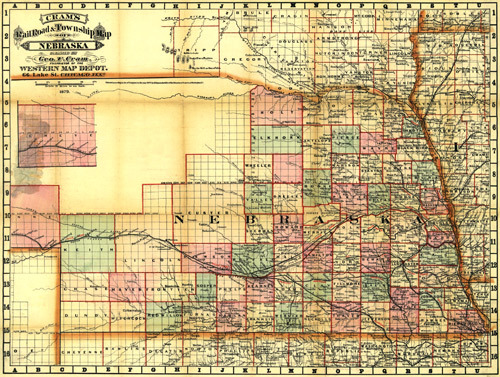

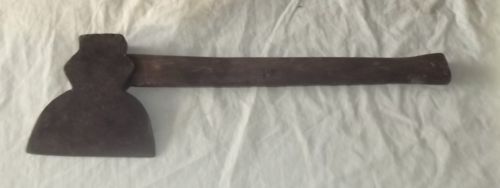
In the early months of 1878 Stephen D. Richards was travelling with a new companion. They had been on the road for a few weeks when they had an argument. Richards shot his friend in the head, a nameless man from Iowa. This was the beginning shot of a serial killer. Richards grew up moving around, his family finally settling in Iowa. In his teen years he spent some time working at the Iowa Lunatic Asylum in Mount Pleasant, where he buried the dead patients.
“That took away to some extent my feeling and sympathy for mankind. I could stand by a man and see him die with no more feeling than I would have for a hog. When I left there… I didn’t care for anything and had no respect for human nature.”
After leaving the asylum he traveled around, trying to find purpose to his life. This is when he killed the man in 1878. “We had raised up in our blankets and had not put on our boots when I made some careless remark about a trifling matter. He says "That’s a damned lie.” “It’s a good thing you don’t mean all you say,” I told him. “But I do mean it,” he said. “You don’t want to mean it,” I said; and he picked up his revolver and saying, “Here is something that backs all that I say,” cocked it. I looked at him, and thought, “The fool acts as if he means to shoot,” and skipping out my little 33 I plugged him one in the head. That was the first trouble we had ever had"
He ended up in Kearney, Nebraska, where he landed himself in jail for a minor crime. There he met the wife of a horse thief named Mrs. Harelson. She invited Richards to visit her once he was free and this led to him visiting her often, enjoying her lifestyle, company and most of all, her home. He decided to murder Mrs. Harelson and her family, 2 daughters and a baby son, so he could claim their home as his own.
In October of 1878 Mrs. Harelson made plans to move to Texas to join her husband. She also made a deal with Richards to sell him the house. Soon after, in the early morning hours of an early November day, Richards snuck in and killed the entire family with an axe. He buried their bodies on the property then took off to sell some of their stuff. The next day he returned and took over the Harelson household. Everyone assumed she and her family had moved to Texas so he got away with it.
He got comfortable, even made a new friend, a neighbor named Peter Anderson. On December 8th or 9th of 1878, Anderson got sick from some of his new friend’s cooking. He thought he had been poisoned by Richards, which wasn’t the case, but confronted him about it anyways. Richards reacted by beating Anderson to death with a hammer. Later he would claim poison wasn’t his style.
After killing Anderson he fled east and was captured in Mount Pleasant, Ohio. He was sent back to Kearney where he was hanged on January 15, 1879. Before he died he wrote some biographical articles for local newspapers in which he confessed to another murder of a man who tried to rob him. Though he is suspected of more murders, it is known for sure that during 1878 Stephen Richards started killing and by year’s end had taken 6 lives.
Pictured above: a knot that is supposedly from the rope used for Richard’s execution, an old map of Nebraska at the time, where Nebraska is in America and lastly a hatchet from the 1800s which was probably like the one he used on the Harelsons. I looked for more pictures but I found none related to the case, not even newspaper articles. If you happen to know of some resources that might help me locate some pics or newspaper pages about this story certainly let me know.
83 notes
·
View notes
Photo
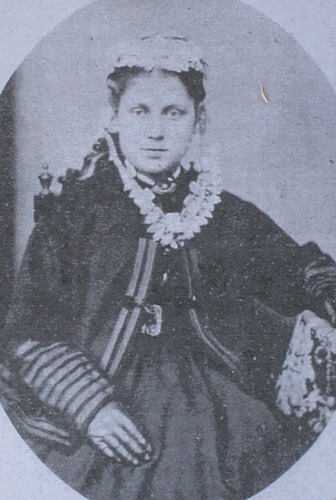



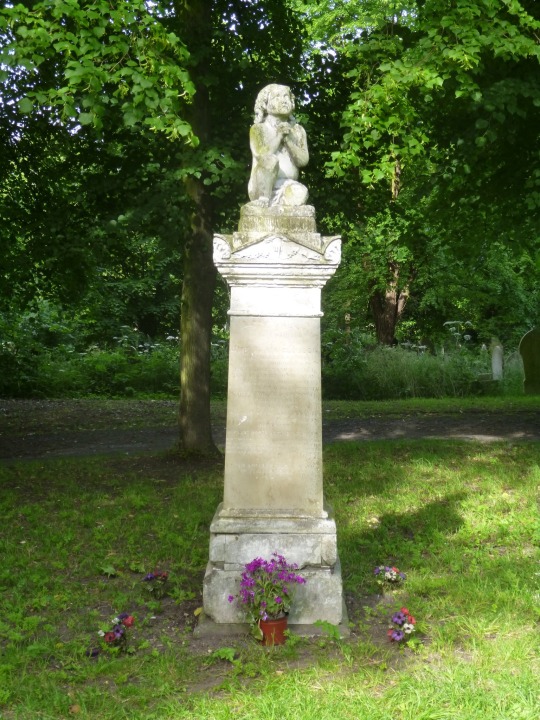

April 25th, 1871, south-east London, a brutal murder took place that rocked the little town of Eltham and left a lasting legacy of nightmares. Jane Maria Clouson, a 17 year old maid working for a well off family named Pook fell in love with the son of her boss. Jane and Edmund Walter Pook had an affair which, as these things tend to do, led to a pregnancy. But Edmund wanted nothing to do with marriage, at least not with Jane. His older brother had married “below his class” and Edmund told himself he would not do the same.
On April 25 Jane was found beaten to near death with a hammer on a small lane in Eltham. She was barely conscious but was able to name her attacker as Edmund Pook. Her last words were “oh, let me die…” which she sadly soon did. Police found the murder weapon near by, a bloody hammer that was purchased by Pook days before. Also, witnesses claimed to have seen Jane and Edmund together on that fateful evening. Lastly it was discovered his clothes were covered in mud and blood. Pook was arrested and sent to trial for the murder.
It seemed like an open and shut case, but unfortunately it wasn’t. Firstly, the judge claimed that Jane’s last words were hearsay and he wouldn’t allow them as evidence. Next the judge gave the police some shit, he said they pestered and hounded Pook until they finally arrested him with no real evidence to back it up. Pook claimed the blood on his clothes was his own, from a bite to his tongue after suffering a seizure. Though the witnesses saw a man fleeing the scene that night they did not get a proper look and couldn’t identify Pook, the eyewitness testimony was useless. The jury didn’t feel there was enough evidence against him, they felt they had a reasonable doubt, and so, shockingly, Pook walked.
During the last day of his trial a huge crowd waited for the verdict who expected justice, but when it came in the people were disappointed and very mad. Most people thought that the elder Pook, Edmund’s rich father, had used his upper class connections to get his son off the charge of murdering the poor servant girl. Jane’s funeral brought thousands of mourners, some dressed in maids uniforms, to honour her memory.
On the 143rd anniversary of Jane’s death, April 2004, a campaign group called Women Against Violence Expressing Solidarity, or W.A.V.E.S, gathered at Jane’s grave to remember her and raise awareness of the fight against violence towards women. W.A.V.E.S helps to “build visible support for an approach that tackles violence against women and girls.”
Much like Jane’s mourning family, the Pooks never escaped the infamous murder. Everyone thought Edmund was guilty and everyone made it very clear. They eventually fled England and changed their names to avoid the notoriety and hatred the public had towards Edmund Pook, the high class suspected murderer. The crime would become known as the Eltham Murder and has become an infamous case of south London history.
Pictured above: a photo of Jane Clouson, a newspaper article about the crime, a depiction of the crime, a depiction of accused murderer Edmund Pook and finally Jane’s grave and a close up of the headstone.
57 notes
·
View notes
Photo


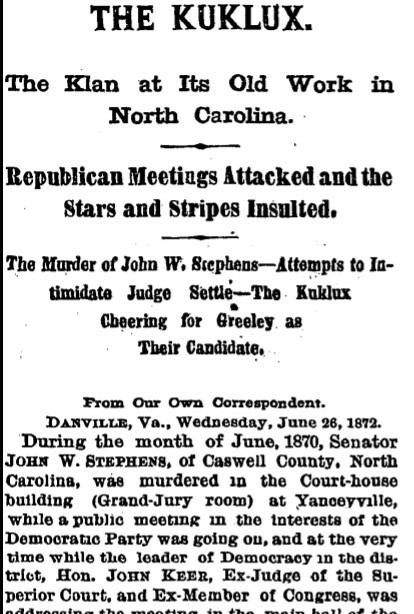
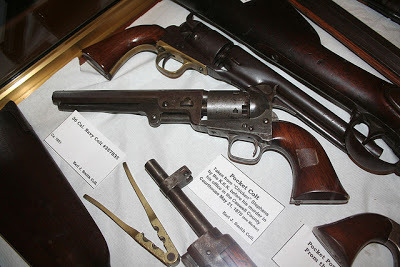

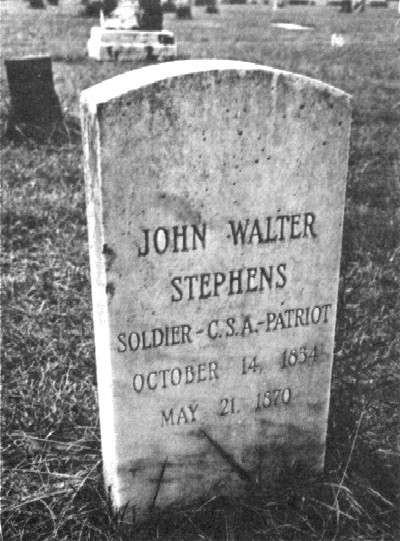
Born on October 13th, 1834, John W. Stephens was a complicated man. He fought for the south in the Civil War only to become a Senator, a tobacco salesman, an early civil rights worker and finally was assassinated by the Ku Klux Klan. During the Civil War he was based in Greensboro, North Carolina and served the Confederate Army commandeering horses. He later would become and ‘impressment agent’, which meant he was out looking for draft dodgers for the south. It’s unclear whether he actually took part in any battles during the Civil War, and after it was over he returned to Wentworth, Rockingham County.
While he was living in Wentworth he made a mistake that would cause his peers to ridicule him and give him a new nickname that would follow him for life. One night a chicken made its way onto his property and, being a probably hungry late eighteen-hundreds man, Stephens shot the bird dead. Now accounts are varied as to whether it was his chicken or whether it was someone else’s, but either way a man named Thomas A. Ratliffe complained to the sheriff and Stephens spent the night in jail. When he got out he found Ratliffe and confronted the man with a loaded gun. The gun was fired, but Ratliffe was not hurt. However, two innocent bystanders were. It’s unclear if Stephens spent more time in jail for this outburst but from that day forward he became known as Chicken Stephens.
In 1886 he moved to Yanceyville, still a tobacco trader, he also began working for a number of political parties. One of which was the Freedmen’s Bureau, a US government agency established to aid freed slaves in the south during the Reconstruction Era of the U.S. He also joined the Republican party and the Union League, which is a group of Men’s Clubs established during the Civil War that promoted loyalty to the Union. Because he was so popular with the black population of Yanceyville he was elected to the North Carolina Senate in 1868. The white population was not happy. They did not like him and they much prefered the older Senator Bedford Brown. After the election the white community isolated him completely, he was thrown out of his Methodist Church, there were even rumors about his personal life saying that he had burned down buildings and the crop fields of fellow citizens. His political opponents even went as far as to claim he had murdered his own mother. None of these claims against him were substantiated and there was no form of any legal action against Stephens.
Due to his notoriety with the heavily-armed white society he became heavily armed himself. He also took out a large life insurance policy. His political activities really irked the KKK of North Carolina, they held a trial and he was convicted in absentia and sentenced to death. Obviously we all know that the KKK isn’t a law-abiding society with rational minded members but even this mock trial and conviction was thought to be ridiculous.
On May 21st 1870 this ridiculous sentence was carried out. Stephens was attending a democratic gathering in the local courthouse when a man signaled to him, Stephens followed the man downstairs. Waiting for him on the first floor were eight to twelve members of the KKK. They murdered him on the Caswell County Courthouse floor. Now although John Stephens wasn’t exactly the brightest bulb and he had a lot of dumb moves in his past, he did work for the freed slaves of America. He helped to establish their rights and he worked with their associations. He helped, or at least tried to help, and was killed for it by a group of small minded racists.
Pictured above: John W. Stephens, the KKK, a newspaper clipping about the murder, a pistol owned by Stephens, the courthouse where it happened, and lastly Stephen’s grave.
41 notes
·
View notes
Photo



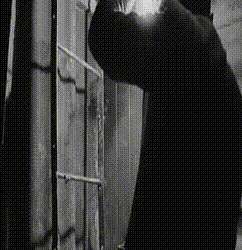

On April 21, 1957, Mrs. Marshall of Lewisham Park in London, found a note beside her backyard fence. The contents of the note were spine chilling. It was from a young lady being held hostage in a dug out prison underneath her neighbors shed. The police were called and they searched the house of John Raymond Bridal. Sure enough, just as the note said, there was 28 year old Marjorie Jordan, locked in a reinforced cellar under the shed. It was made up like a small apartment, bed, chairs, table, and even a radio. Bridal was immediately arrested and Marjorie was taken to the hospital.
She was seized from her room in a boarding house on January 7th by Bridal. He broke into her room, tied her up and kidnapped her on the back of his motorcycle. He took her back to his house where he told her he needed help with his inventions. He wasn’t exactly lying, he was an inventor, at least he wanted to be, but her main job would be digging. Digging his under shed dungeon so there would be more room for his inventions, and, oddly, for his laundry. He didn’t sexually assault her, but he did force her to obey his instructions. When she didn’t listen he made her undress in front of him or beat her. So she dug, for 105 days she was trapped in Bridal’s twisted world. Finally, as she was being led to the washroom one night, she managed to sneak the note over the fence which was her only view for the past few months.
Bridal went to trial at the Old Baily. Though he professed she was only helping him and was there consensually, he ended up pleading guilty to unlawful imprisonment and assault. The court only gave him a sentence of a measly three years. Of the whole incident Marjorie had this to say:
“I shovelled out earth and put it into buckets which he pulled up. Sometimes we loaded as many as sixty buckets a day…He would come into the room each night and let me come up to his house…He would stand guard outside the bathroom door while I washed. Then he would lead me back to the room…He got an electric stove and fixed up the current in the hole and everyday he would lower down food which he bought from shopping lists I made out for him…About three weeks ago he decided I was resigned to my fate and he let down a wireless set…I had my handbag compact, luckily, so I was able to do my face each day and keep my self respect a bit…But, golly, how I longed to go to the hairdresser or else have a darned good bath.”
That british 1950s stiff upper lip really showing.
Pictured above: gifs from archival footage, first is Marjorie Jordan, then John Bridal (in glasses), Mrs. Marshall demonstrating where she found the note and a few shots of his underground lair.
193 notes
·
View notes
Photo
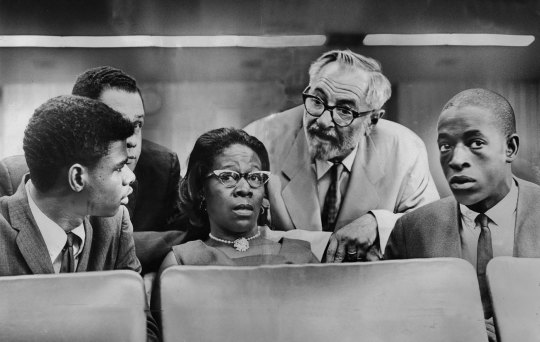

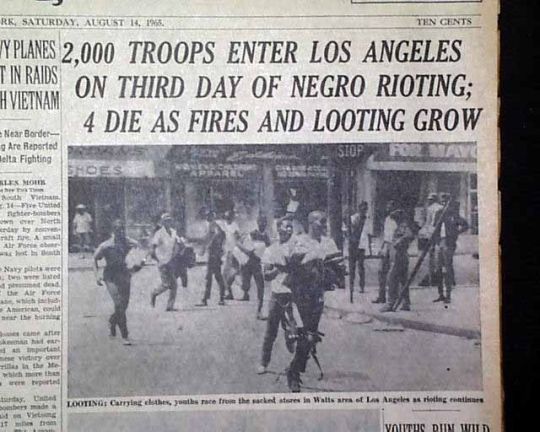







In 1950 Los Angeles elected William H. Parker as the Chief of police. He brought with him a militaristic mentality, changing the L.A.P.D into a professional, strict and strong police force that was called one of the best police forces in the world by the 1960s. Not everyone felt this way, particularly the non white citizens of L.A. Due to its harsh military like stance on minor and non existent instances, the thin blue line was soon facing criticism of police brutality from the Black and Latino community.
On Wednesday, August 11, 1965, Marquette Frye, a 21 year old black man, was pulled over for reckless driving. The white officer arrested Frye after he gave him a field sobriety test. While that was happening, Ronald Frye, Marquette’s brother and passenger, had gone to retrieve their mother from the family home which was nearby. She gave Marquette shit for drunk driving, as she should have, but amidst the yelling someone pushed her and Marquette was hit. His mother didn’t like that so she jumped the cop who had done it, this resulted in a fight that only ended after guns were brought out and backup was called. Crowds were watching the scene and as Marquette was manhandled into the back of a cop car the crowd got angry. They began yelling at the police, throwing things at them. Marquette’s mother and brother were also arrested. The anger surged through the neighborhood, crowds growing and showing the police they did not like the way the situation was handled. More cops showed up, more people showed up, pretty soon a huge chunk of L.A would be in the midst of a massive and disastrous riot now known as the Watts Riots. The police chief called in the national guard, comparing the riots to the insurgency of the Viet Cong. He wanted a paramilitary response to the riot which was destroying the Watts area. 2,300 national guardsmen were called in. By Saturday there were 16,000 law enforcement personnel on the scene, which only enraged the rioters more. They threw bricks and concrete at the cops, destroyed their vehicles. Rioters fought with police and blocked fire dept. vehicles from getting to emergencies. The white owned stores were looted and burned down. Over a 6 day period between 31,000 and 35,000 people rioted on the streets of Los Angeles. It was only ended after Chief Parker instituted a curfew and a mass arrest policy. Anyone out in certain areas after 8 p.m. were locked up. After all was said, done and burnt there were over 3,000 arrests, over 1,000 injuries and 34 lives lost. It left L.A with $40 million in property damages and a major rift in the racial communities of L.A. White people were scared, fearful that the next arrest could lead to another riot. African American and Latino people saw the riots as a positive, an uprising against an oppressive system. In 1966 Bayrard Rustin, a civil rights activist, wrote of the riots:
“The whole point of the outbreak in Watts was that it marked the first major rebellion of Negroes against their own masochism and was carried on with the express purpose of asserting that they would no longer quietly submit to the deprivation of slum life.”
The Frye brothers and their mother, Rena Price, were eventually released, and, after all the mayhem of the riots, Rena never recieved her car back from the L.A.P.D impound, the car Marquette was driving that night that broke the camel’s back. The fees on storage were more than the car was worth.
Pictured above: The Frye brothers and Rena Price their mother, Chief Parker, a news clipping about the police reaction, some pictures from the riot, a few gifs I made from archival footage of the riot and lastly some more newspaper headlines about the chaos.
191 notes
·
View notes
Photo

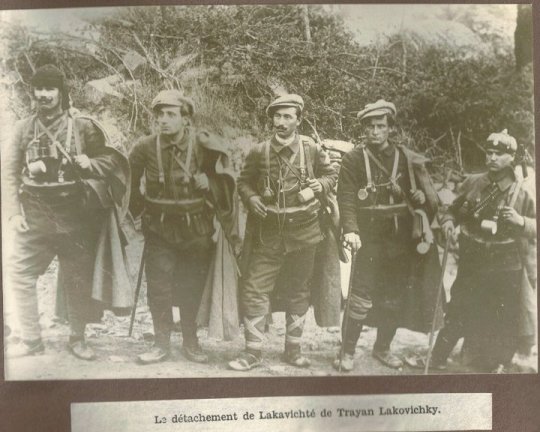

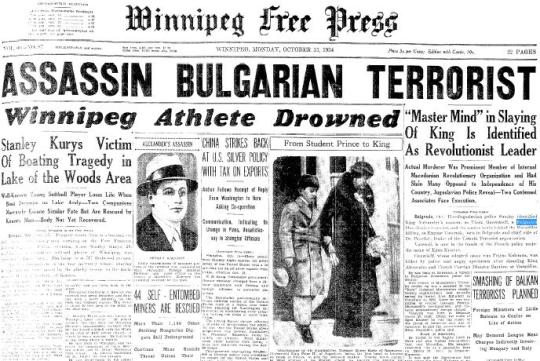
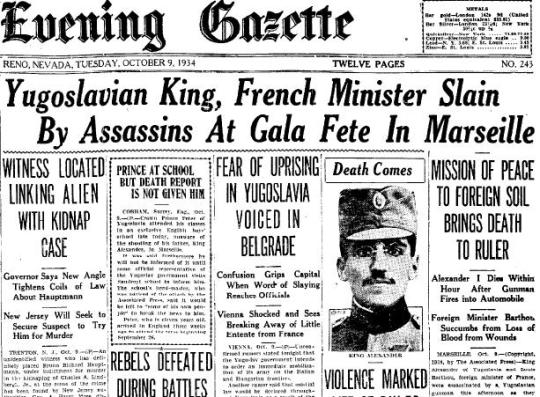

Velichko Dimitrov Kerin, more infamously known as Vlado Chernozemski, was born in 1897 in Bulgaria. During World War One he joined the army and served as an engineer. After the war he got married, had a daughter, and worked as a driver and a watchmaker until 1922. It was then that he joined the IMRO, the Internal Macedonian Revolutionary Organization, and he started in the life of a revolutionary. He got into fights with Yugoslavian police, known for his courage and his marksmanship, he soon became a top level assassin for the organization. He was ordered tl kill a former IMRO member and was arrested and sentenced to death for the crime, but it never happened. He escaped in 1925. In 1930 he assassinated another IMRO member and again was arrested and sentenced to die, this time he got a pardon in 1932 and was released. After getting out of prison he went into hiding at a revolutionist camp. He was transferred to a special camp which taught him specifically how to assassinate a King.
Alexander I, King of Yugoslavia, wasn’t too popular with the free thinkers of the time. In 1929, out of fear of a political crisis after a major leader was assassinated, he abolished his country’s constitution and instituted a dictatorship. By 1931 he was in control of the entire country, elections were rigged and voters were pressured. The IMRO and the Ustaše, a Croatian revolutionary movement, wanted him out. After an Ustaše uprising King Alexander said:
“If you want to have serious riots in Yugoslavia or cause a regime change, you need to kill me. Shoot at me and be sure you have finished me off, because that’s the only way to make changes in Yugoslavia.”
On October 9th 1934 Vlado would make the King’s proclamation come true. While the King was visiting Marseille he and the french foreign minister, Louis Barthou, were driving slowly through some welcoming and adoring crowds. Vlado emerged from the crowd, hiding his gun in a bouquet of flowers, he shot the King at point blank multiple times. Alexander was hit in the heart and died pretty much instantly. Vlado also killed the car’s driver. Barthou was hit, and due to inadequate medical attention among the chaos of the assassination, he also died. Vlado then was almost apprehended but he shot the police officer who had him and killed two innocent bystanders. He was hit by a calvaryman’s sabre which gave him a slash bad enough to stun him. Then he was shot in the head by a pissed off police officer, but the bullet didn’t kill him. The crowd then took their anger out on him, beating him mercilessly as the police watched. He was finally arrested and brought in for interrogation, but he was in rough shape. He couldn’t speak and died a few hours later. The king was brought home and, after a funeral attended by 500,000 mourners, was buried in the memorial church of st. George. Vlado was buried in an unmarked grave. The assassination was the first ever to be caught on film.
Pictured above: Vlado, Vlado with other revolutionaries (he is second from the left), the King moments before the assassination, some newspaper headlines from the time, and lastly the gun Vlado used.
49 notes
·
View notes
Photo
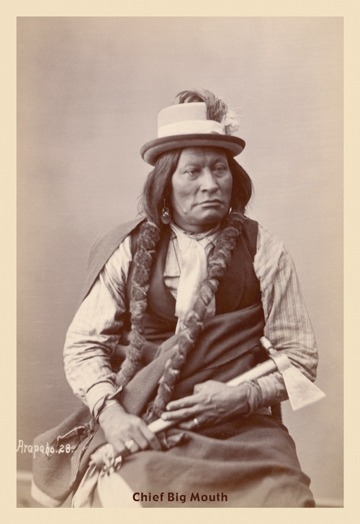
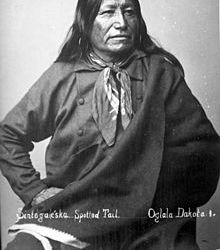

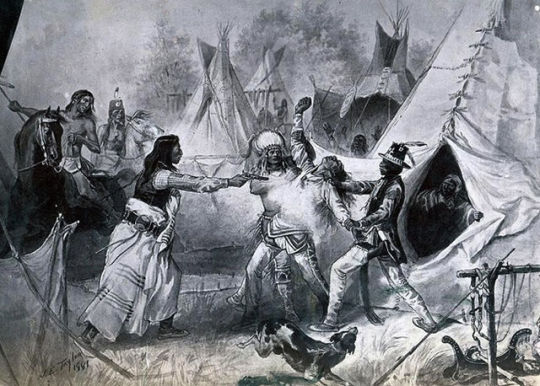

Big Mouth was born in 1822 and he would eventually become a highly respected leader of one of many Brulé Lakota tribes. He was known for his aggressive military leadership and was one of the signers of the second Treaty of Fort Laramie. The treaty was an agreement between the U.S. and Native American tribes which guaranteed Lakota ownership of the Black Hills and their hunting rights in South Dakota, Wyoming and Montana. Big Mouth, rightfully so, didn’t trust the treaty (which would eventually lead to Red Cloud’s War between 1866 and 1868) and criticized another leader named Spotted Tail, saying he had been bought by American politicians. Spotted Tail was a fellow Brulé Lakota chief who became convinced that fighting the white man was a futile effort. Big Mouth did not agree with him.
On October 29th 1869 Spotted Tail called on Big Mouth to speak with him. When Big Mouth showed up he was immediately grabbed by two other warriors. Spotted Tail drew a pistol and shot Big Mouth dead. Captain DeWitt C. Poole gave a fairly detailed account of Big Mouth’s twin brother Blue Horse’s reaction:
“Blue Horse started a violent harangue in the Sioux language. He had a rifle in one hand and a strung bow and a bunch of arrows in the other, and when he dropped his blanket, two navy Colts and a big scalping knife could be seen in their sheaths at his belt. He was in a raving fury, leaping and bounding about the room as he hurled accusations and threats at Chief Spotted Tail. Chief Big Mouth died toward dawn. Some hours later, Blue Horse came to agent Poole’s office and told he that he felt so sad over the death of his great and good brother that he would have to wash off the paint he had put on his face for the feast the day before and begin mourning. The interpreter warned Poole that if this Indian washed his face and started mourning, it would mean the reopening of the feud and more shootings. The agent would give Blue Horse two blankets, that would comfort him, and he would refrain from washing his face and going gunning for Spotted Tail. The blankets were handed over, and the grieving brother went quietly away.”
Although Blue Horse was urged to avenge his brother’s death by many of his tribe, he decided to go the path of nonviolence and moved away. It was a cold and brutal murder occurring because one man did not agree with another man’s point of view. There no there was no retribution for this brave Brulé Lakota warrior.
Pictured above: a picture of Chief Big Mouth, a shot of his killer Spotted Tail, a map of the land the Treaty of Fort Laramie had promised, a depiction of the murder and lastly his twin brother Blue Horse.
71 notes
·
View notes
Photo


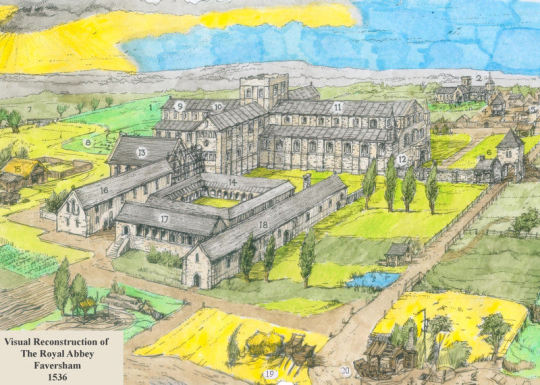


Alice Brigantine married Thomas Arden and settled in Faversham Abbey in the Civil Parish of Faversham, Kent, England. It was not a very happy marriage and even though they had at least one daughter, Alice soon began an affair with a man named Richard Mosbye. Alice and Richard carried out their Affair rather openly and her husband turned a blind eye. She was very unhappy with Thomas and decided he had to go.
Her first attempt was to mix poison and milk and serve it to him for breakfast, but she’d failed to realize that the poison tasted very strongly and Thomas could not to finish his meal because it tasted so bad. She came to the conclusion that she needed help. She gathered quite a crew to assist her in the assassination of her husband. Along with Richard there was John Green, George Bradshaw, and Black Will. Green had a past with Thomas. Once he had tried to claim some land behind Faversham Abbey and Thomas shut him down. The two men even fought at one point, so Green, who considered Thomas and enemy, was happy to join the murderous plot. Black Will was an old Soldier who was mainly their muscle but had experience with murder.
Another attempt was made one night while Thomas was walking near St. Paul’s Cathedral, but the conspirators could not find the right time to make their move. Yet another time they waited for their prey and again failed to find the opportunity to murder him. Finally Alice decided that she would have to murder them in their own house away from public eyes. She found even more accomplices,Richard’s sister and even two of Thomas’s servants were quick to join in.
On February 15th, 1551 it finally happened. After dinner, with Black Will hiding in a closet, Thomas sat down to play a game with Richard. Will snuck out and threw a napkin over his face and began to strangle him. Then Richard stepped up and hit him with a pressing iron on his head, cracking his skull then he withdrew a knife and cut his throat. Alice stepped up to make sure he was dead and stabbed him seven or eight times. They then dragged the body into a closet, paid Black Will and eventually brought the body to a meadow behind the abbey.
There are two separate accounts as to what happened next, one says Alice waited till the next morning to alert the town and the other says that she started that night too show fear and terror at the thought of her husband not coming home. A search was conducted and when the body was finally discovered people began to doubt the sincerity of Alice. The body was only dressed in a nightgown and slippers and it was such a cold snowy night it was very unlikely he was just going about his business when he was murdered. Also the snow had preserved several footprints between the body and the house of the Ardens, making it pretty obvious that it had been brought from the abbey. Alice of course denied any knowledge of the crime, but the townspeople conducted an investigation and found hair, blood, the bloody knife and a bloody cloth near Alice’s house. She was arrested and forced to confess her guilt and also named all of her associates. Everyone involved was arrested.
Alice was found guilty of murder and in front of a very large and excited crowd she was burnt at the stake in Canterbury. Brutally, reports from the time to suggest that she survived on the stake for over an hour before finally succumbing to the flames. Her accomplices were also executed by various methods, one was drawn and hanged, one was burned at the stake, two were hanged, and one was hanged up in chains at Canterbury. John Green was hung in Faversham although he evaded arrest for many years. As for Blackwell he was the only person found innocent of murder because there was no direct evidence between him and the crime. He escaped for many years but eventually he was arrested for something else and executed in Flushing, a city in the southwestern region of the Netherlands.
Pictured above: a depiction of the murder, a flyer for a play about the crime, Faversham Abbey in the 1500s and as it is today and lastly a plaque about the murder.
50 notes
·
View notes
Photo





Born in Austin County, Texas on October 6th 1851, William Preston Longley, a.k.a Wild Bill Longley, became a murderer and American outlaw just after the American Civil War. He was raised near Evergreen Texas which is where he learned how to shoot. In December 1868 three former slaves were riding through Evergreen on their way to visit friends. Longley, with a couple of his friends, ambushed the three men and forced them to get off their horses. One of the men panicked and tried to escape. Longley shot him several times. In 1869 Longley and his brother-in-law began a crime spree across south Texas where they robbed settlers and even murdered a few freed slaves. In 1870 the Union Military Authority offered a reward of $1,000 for their capture.
Avoiding the bounty hunters who were now after him, he left Texas and headed north to Cheyenne, Wyoming, where he was going to try his hand at mining for gold. In June of 1870 his mining party came across a U.S. Cavalry unit in the Black Hills of South Dakota. Longley decided to enlist and was signed up for a five year commitment. He deserted only two weeks later, unable to deal with military life. He was soon captured, court-martialed and sentenced to two years of hard labour. He only served four months when they returned him to his unit. He deserted once again in May of 1872. In February 1873 he returned to Texas and it was not long until he was back at what he did best, killing. He was accused of murdering yet another freed slave before fleeing to Bell County Texas. On March 31st 1875 he shot and killed his childhood friend Wilson Anderson with a shotgun. Longley’s uncle Caleb B. Longley blamed Anderson for the death of his son and wanted his nephew to take revenge.
Once again he was on the run and traveled from town to town using different names to avoid arrest. He worked on a cotton farm in 1875, but he murdered a friend of his after they got into a fight and was forced to run. Again he killed in 1876 when he ambushed Lou Shroyer. Shroyer was also an outlaw and was not afraid to return fire. Longley was shot off his horse but got in the final shot, killing Shroyer. He then went East and became a sharecropper for a preacher named William R. Lay. He got into a love triangle situation with a young woman and Lay’s nephew and ended up beating the nephew to a bloody pulp. He was jailed and escaped yet again, blaming William Lay for his problems. Longley found him in his barn milking a cow and killed him with a shotgun.
On June 6th 1877 Longley was finally arrested while staying in De Soto Parish, Louisiana, under the name Bill Jackson. He was returned to Texas, tried and convicted for the murder of William Anderson. He was executed on October 11 1878 when he was 27 years old, only a few miles from his hometown of Evergreen. He claimed that he’d killed 32 people throughout his life, mostly Hispanic and African-Americans.
Years later Longley’s father came forward to say his son was still alive. He claimed that they had bribed lawman $4,000 to rig a trick rope on the gallows. Evidence such as letters from the outlaw since the execution were presented and for a while the legend was believed. In June of 2001 DNA tests were conducted and it was officially concluded that the remains in his grave were indeed that of Wild Bill Longley.
Pictured above: William Longley, a wanted poster for him, Longley arrested, a newspaper illustration of his execution and likeness and finally the plaque that marks his grave.
61 notes
·
View notes
Photo


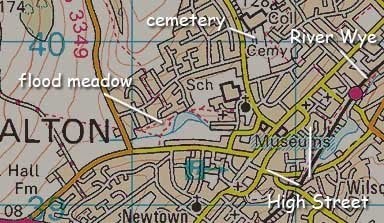

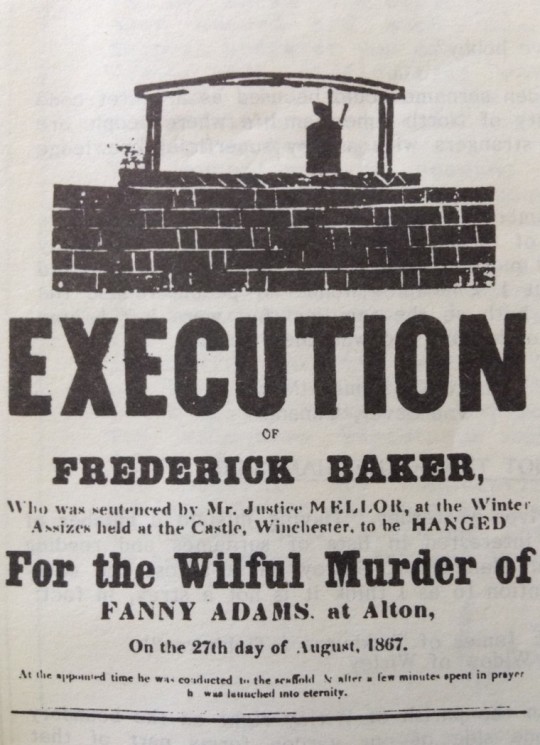


On Saturday August 24th 1867, Fanny Adams, 8 years old, Minnie Warner, 7 years old, and Elizabeth Adams, Fanny’s sister who was only 5, were walking up a lane towards Flood Meadow in Alton, England. They came across a solicitor’s clerk named Frederick Baker. He was 29 years old and looked to be quite respectable in a business suit and tie. He offered two of the girls some money so he could be alone with Fanny, and they took it and took off. Sadly, all though she tried, Fanny was unable to escape and Baker brutally murdered her in a hops field. Around 5 o'clock, when the two young girls returned home they informed a neighbour who told Fanny’s mother. Panic set in and she ran up towards Flood Meadow. On the way she came across Baker as he was coming down the lane. They questioned him but he told them he hadn’t seen her and again, due to his respectable appearance, Mrs. Adams let him go and continued the search for Fanny. Later that evening they found her body. She had been mutilated almost beyond recognition.
Baker was arrested at his offices on High Street and was led through a very angry mob to the police station. Although he claimed innocence there was immediately quite a bit of evidence against him. He had blood stains on his shirt and trousers and also two small blood-stained knives on his person when they arrested him. One of Baker’s drinking buddies also said that on the night of the murder, Baker said he was going to be leaving town that night, and he could find a job somewhere as a butcher. On August 28th they found his diary and in it they found a short but horrible entry: “24th August, Saturday - killed young girl. It was fine and hot.”
He was sent to trial and although he tried to claim insanity the jury found him guilty after only 15 minutes of deliberation. He was hanged on December 24th 1867. Fanny was buried in Alton Cemetery.
The phrase “sweet Fanny Adams” or “sweet F.A” (also known as sweet fuck all) was derived from this case. In 1869 British sailors had been given a a new type of tinned mutton, the macabre joke of the time was it may be the remains of Fanny Adams. So, Fanny Adams became a slang for mutton, then it became slang for anything worthless. Nowadays the phrase means “nothing at all”.
Pictured above: a picture of what is thought to be Fanny Adams, Alton England where the crime took place, a more detailed map that shows how close Flood Meadow is with High Street, an illustration of Baker, a clipping about his execution, Fanny’s headstone and lastly a picture of the two girls that were lucky to escape visiting Fanny’s grave.
194 notes
·
View notes